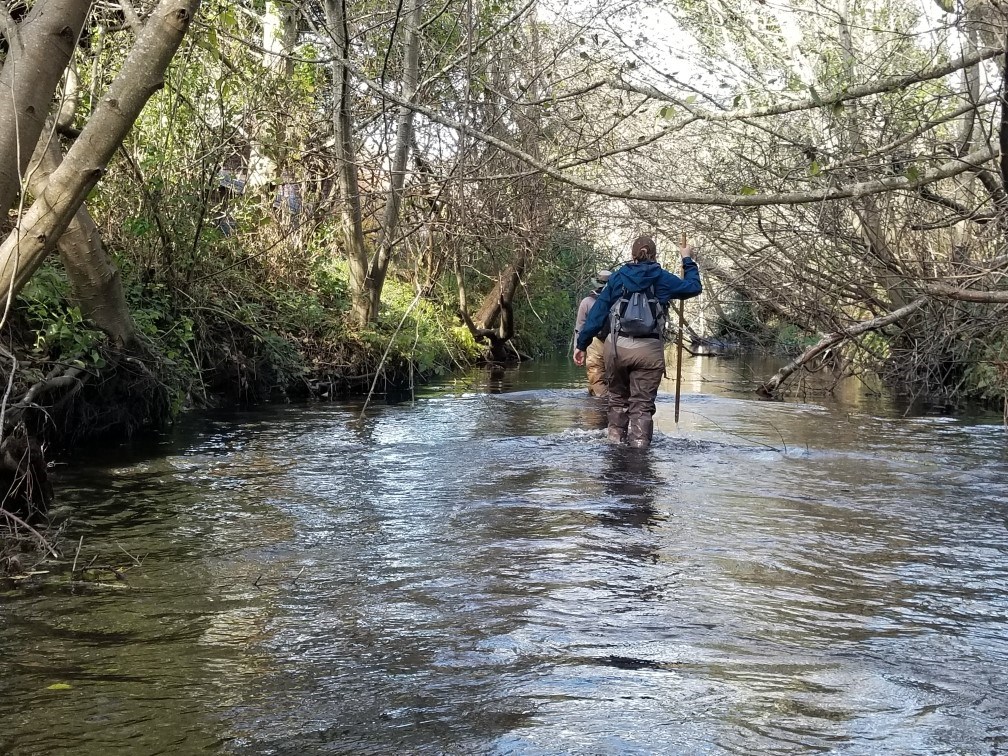Last updated: September 17, 2020
Article
Winter 2019-2020 Coho and Steelhead Spawner Survey Summary
A big thank you to all our volunteers who participated in the 2019-2020 coho and steelhead spawner surveys! Through your dedication and flexibility, we were able to successfully complete most of our spawner surveys. We only missed a few survey opportunities towards the end of the season due to the COVID-19 pandemic.
2019-2020 Spawner Season Overview
Looking ahead to next season!
We anticipate more promising numbers of adult coho for the 2020-2021 spawner season, especially on Redwood Creek. During the spring of 2019, we estimated that almost 3,000 coho smolts migrated out of Redwood Creek. Based on average ocean survival, we expect to see 50-60 adults return this winter. The Olema Creek coho run will likely be, with less than 15 returning adults anticipated based on average ocean survival and the 2019 smolt outmigration estimate. However, Olema Creek is part of the larger Lagunitas Creek population, and the number of returning coho is often dependent on rainfall and the overall watershed run size.
Coho salmon are three years old when they return to their natal stream to spawn. These spawners are the offspring of salmon that spawned three years prior, and the parents of the generation that will spawn in another three years. As a result of this life history strategy, there are three distinct year classes, or cohorts, of coho spawners in each creek. Each has its own trends that may only be tracked every third year. The 2019-2020 spawner cohort is primarily descended from salmon that spawned in the winter of 2016-2017.
During the last week of November, the Olema Valley rain gauge recorded over two inches of rainfall. An additional four inches fell during the first week of December. By the second week of December, conditions were ideal for coho spawning. However, spawner surveys conducted during the first two weeks of December revealed only one coho salmon redd in both Olema and Redwood Creeks and no coho activity in Cheda Creek. By the end of December, it became apparent that the coho runs in coastal Marin County would be weak, and that survival between the smolt and spawner life stages for these cohorts was very low.

Teague Tran
Although the coho return was disappointing, crews saw steelhead in Redwood Creek, Pine Gulch Creek, and Olema Creek. May rains attracted a few additional steelhead spawners. On the final survey of the season, in mid-May, we counted eight steelhead redds on both Olema and Redwood Creeks.
Preliminary Spawner Season Result Details
Note that live adult coho and steelhead totals may include repeat sightings.
Redwood Creek
The Redwood Creek lagoon breached on November 30th, which allowed adult salmonids access to the system. Monitoring crews observed two live coho on December 13th, and one live coho on January 2nd. We found only three coho redds this season. This is a significant decrease compared to the redd count of 16 in winter 2016-17. In contrast, we counted a total of 17 live steelhead, four steelhead carcasses, and 60 steelhead redds from late-December through mid-May. Due to the COVID-19 pandemic, we were unable to conduct surveys from mid-March through mid-May. The last Redwood Creek spawner survey before the shelter in place order occurred on March 11th. The fisheries crew did not return to Redwood Creek until May 15th for the final survey of the season.
Olema Creek
We encountered the first live coho in Olema Creek on December 5th. Our last coho observation was of a carcass that we found on January 27th. Overall, we counted 17 live coho, three coho carcasses, and three coho redds. However, we likely sighted the adult coho more than once, and most appeared to be males waiting for a female mate. Thus, the true live adult total may have been lower. This is further supported by the observation of only three redds. In addition to coho observations, we recorded five live adult steelhead, one steelhead carcass, and 19 steelhead redds. The last Olema spawner survey prior to the shelter in place order occurred on March 11th. The fisheries crew did not return to Olema Creek until May 20th and 22nd to perform the final surveys of the season. Like Redwood Creek, Olema Creek coho redds decreased substantially compared to the last time this cohort returned to spawn. Juvenile surveys in the summer of 2020 will validate coho spawner counts in Olema and Redwood Creeks.
Cheda and Pine Gulch Creeks
Crews recorded no coho observations and one steelhead redd in Cheda Creek this season. Additionally, we recorded no coho on Pine Gulch. However, we did find one live steelhead and 17 steelhead redds on Pine Gulch.
Trends in Coho Salmon Spawning
The 2019-2020 cohort on Olema Creek has suffered a significant and continuing decline in redd production since the 2004-05 season. Although the redd and live spawner counts on Redwood Creek were also minimal, returns for this cohort have been similarly weak since the winter of 2007-2008. In other words, this cohort has been on the verge of extirpation from both streams for multiple spawning seasons. National Park Service staff have been in contact with the California Department of Fish & Wildlife to discuss contingency plans. For annual coho redd counts observed on Olema and Redwood Creeks over the last 20 years, please see Figures 1 & 2 below.


For More Information
For more information about the San Francisco Bay Area Coho and Steelhead Monitoring Program, contact Michael_Reichmuth@nps.gov or call 415-464-5191.
The National Park Service shall not be held liable for improper or incorrect use of the data described and/or contained herein. These data and related graphics (if available) are not legal documents and are not intended to be used as such. The information contained in these data is dynamic and may change over time. The National Park Service gives no warranty, expressed or implied, as to the accuracy, reliability, or completeness of these data.

